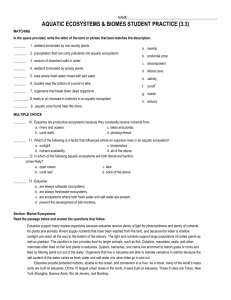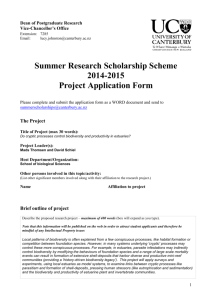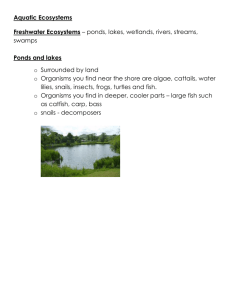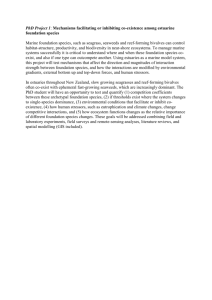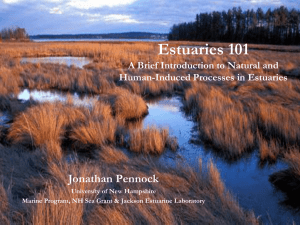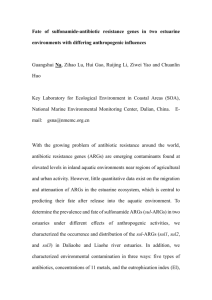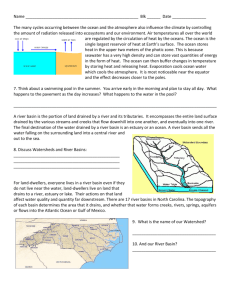Active Reading: Marine Ecosystems
advertisement
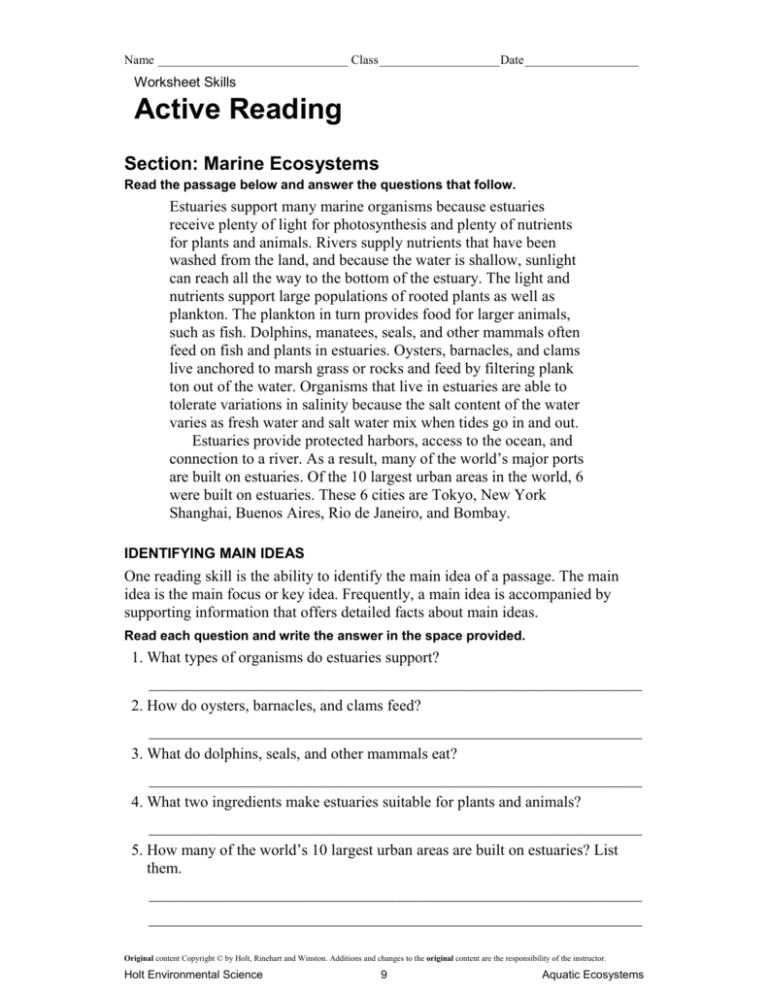
Name ______________________________ Class ___________________ Date __________________ Worksheet Skills Active Reading Section: Marine Ecosystems Read the passage below and answer the questions that follow. Estuaries support many marine organisms because estuaries receive plenty of light for photosynthesis and plenty of nutrients for plants and animals. Rivers supply nutrients that have been washed from the land, and because the water is shallow, sunlight can reach all the way to the bottom of the estuary. The light and nutrients support large populations of rooted plants as well as plankton. The plankton in turn provides food for larger animals, such as fish. Dolphins, manatees, seals, and other mammals often feed on fish and plants in estuaries. Oysters, barnacles, and clams live anchored to marsh grass or rocks and feed by filtering plank ton out of the water. Organisms that live in estuaries are able to tolerate variations in salinity because the salt content of the water varies as fresh water and salt water mix when tides go in and out. Estuaries provide protected harbors, access to the ocean, and connection to a river. As a result, many of the world’s major ports are built on estuaries. Of the 10 largest urban areas in the world, 6 were built on estuaries. These 6 cities are Tokyo, New York Shanghai, Buenos Aires, Rio de Janeiro, and Bombay. IDENTIFYING MAIN IDEAS One reading skill is the ability to identify the main idea of a passage. The main idea is the main focus or key idea. Frequently, a main idea is accompanied by supporting information that offers detailed facts about main ideas. Read each question and write the answer in the space provided. 1. What types of organisms do estuaries support? _______________________________________________________________ 2. How do oysters, barnacles, and clams feed? _______________________________________________________________ 3. What do dolphins, seals, and other mammals eat? _______________________________________________________________ 4. What two ingredients make estuaries suitable for plants and animals? _______________________________________________________________ 5. How many of the world’s 10 largest urban areas are built on estuaries? List them. _______________________________________________________________ _______________________________________________________________ Original content Copyright © by Holt, Rinehart and Winston. Additions and changes to the original content are the responsibility of the instructor. Holt Environmental Science 9 Aquatic Ecosystems Name ______________________________ Class ___________________ Date __________________ Active Reading continued VOCABULARY DEVELOPMENT Read each question and write the answer in the space provided. 6. Write a title for the first paragraph of the reading selection. _______________________________________________________________ 7. Write a title for the second paragraph of the reading selection. _______________________________________________________________ RECOGNIZING CAUSE AND EFFECT One reading skill is the ability to recognize cause and effect. Read each question and write the answer in the space provided. 8. Because water in an estuary is shallow, _______________________________________________________________ 9. Because rivers carry water from places inland to an estuary,. _______________________________________________________________ _______________________________________________________________ 10. Because estuaries receive plenty of light and nutrients,. _______________________________________________________________ _______________________________________________________________ 11. Because the light and nutrients support plankton,. _______________________________________________________________ _______________________________________________________________ 12. Because estuaries provide a connection to rivers, ocean access, and protected harbors,. _______________________________________________________________ _______________________________________________________________ 13. Because the salt content of the water in an estuary varies as fresh and salt water mix with the changing tides, _______________________________________________________________ _______________________________________________________________ _______________________________________________________________ Original content Copyright © by Holt, Rinehart and Winston. Additions and changes to the original content are the responsibility of the instructor. Holt Environmental Science 10 Aquatic Ecosystems TEACHER RESOURCE Active Reading Map Skills SECTION: FRESHWATER ECOSYSTEMS 1. 2. 3. 4. 5. 6. 7. 8. 9. 10. 11. 12. 13. 14. 15. 16. 17. 18. 19. 1. 13 2. Answers may include all species on the map. However, owls, sparrows, and falcons can be left off the list. 3. penguin 4. Answers may vary but should include a large mammal, such as a whale or sea lion. Large predators are usually at the top of a food chain. d a d c b b e a f d c N B P N B B P N Quiz SECTION: FRESHWATER ECOSYSTEMS Matching 1. b 2. d 3. a 4. e 5. c Multiple Choice 6. b 7. c 8. a 9. d 10. a SECTION: MARINE ECOSYSTEMS Matching 1. d 2. e 3. c 4. a 5. b SECTION: MARINE ECOSYSTEMS 1. marine organisms 2. They anchor themselves to marsh rass or rocks and filter plankton outof the water. 3. fish and plants 4. light and nutrients 5. six: Tokyo, New York, Shanghai, Buenos Aires, Rio de Janeiro, and Bombay 6. Answers may vary but should reflect the paragraph’s emphasis on the organisms and feeding relationships of estuaries. 7. Answers may vary but should reflect the paragraph’s emphasis on the value of estuaries to people. 8. Sunlight can reach all the way to the bottom. 9. Nutrients that have been washed from the land are also carried to the estuary. 10. Estuaries are able to support many marine organisms. 11. Larger animals have food. 12. Many ports are built on them. 13. Organisms are able to tolerate variations in salinity Multiple Choice 6. `d 7. b 8. d 9. b 10. b Chapter Test General MATCHING 1. 2. 3. 4. 5. I e h f j 6. 7. 8. 9. 10. a c b g MULTIPLE CHOICE 11. 12. 13. 14. 15. a c b c c 16. 17. 18. 19. 20. c d a b d Chapter Test Advanced MATCHING 1. 2. 3. 4. 5. . b d I j a 6. 7. 8. 9. 10. c e h f g Original content Copyright © by Holt, Rinehart and Winston. Additions and changes to the original content are the responsibility of the instructor. Holt Environmental Science 89 Aquatic Ecosystems

